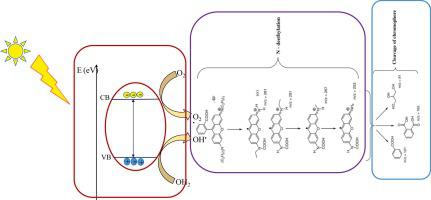FlatChem ( IF 5.9 ) Pub Date : 2021-08-11 , DOI: 10.1016/j.flatc.2021.100277 Timothy O. Ajiboye 1, 2 , Opeyemi A. Oyewo 3 , Damian C. Onwudiwe 1, 2

|
The removal of Rhodamine B dyes (RhB) from wastewater, using the conventional water treatment techniques, usually involves some challenging processes. This is challenging because RhB is a highly soluble and persistent dye found in wastewater. Although some efficient physiochemical techniques have been reported, the limitations associated with these technologies, such as the production of secondary wastes in the chemical precipitation process, cannot be overlooked. Photocatalysis, on the other hand, could transform the dye molecules to less toxic or non-toxic final products without the generation of secondary wastes. Therefore, the combined use of photocatalysis and adsorption processes for the removal of RhB from water has been found to be highly efficient. However, the development of materials that possess efficient adsorption and photocatalytic properties remains a major challenge since most of the known materials have a low adsorption capacity and may not be photostable. Carbon-based materials have been used as an efficient material for the removal of RhB from wastewater due to their high adsorption capacity and light-sensitive properties. In this report, the properties, synthesis and use of the carbon-based materials for the removal of RhB from wastewater are discussed in detail. Different factors that affect the removal of RhB dyes from wastewater and the mechanism of photocatalysis and adsorption isotherms are critically reviewed. Furthermore, limitations of carbon-based materials as both adsorbents and photocatalysts are presented, and the possible methods for overcoming these limitations are also investigated.
中文翻译:

碳基材料吸附光催化去除废水中罗丹明B
使用传统的水处理技术从废水中去除罗丹明 B 染料 (RhB) 通常涉及一些具有挑战性的过程。这是具有挑战性的,因为 RhB 是一种在废水中发现的高度可溶性和持久性染料。虽然已经报道了一些有效的物理化学技术,但与这些技术相关的局限性,例如化学沉淀过程中二次废物的产生,不容忽视。另一方面,光催化可以将染料分子转化为毒性较小或无毒的最终产品,而不会产生二次废物。因此,已发现将光催化和吸附过程结合使用从水中去除 RhB 是非常有效的。然而,开发具有高效吸附和光催化性能的材料仍然是一项重大挑战,因为大多数已知材料的吸附能力低且可能不是光稳定的。碳基材料由于其高吸附能力和光敏特性,已被用作去除废水中 RhB 的有效材料。在本报告中,详细讨论了用于去除废水中 RhB 的碳基材料的性质、合成和用途。对影响从废水中去除 RhB 染料的不同因素以及光催化和吸附等温线的机理进行了严格审查。此外,还提出了碳基材料作为吸附剂和光催化剂的局限性,











































 京公网安备 11010802027423号
京公网安备 11010802027423号